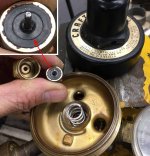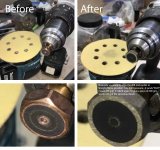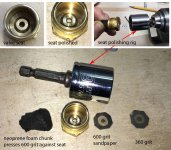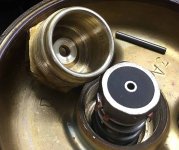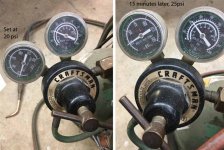Sodo
Elite Member
- Joined
- Apr 21, 2012
- Messages
- 3,197
- Location
- Cascade Mtns of WA state
- Tractor
- Kubota B-series & Mini Excavator
I had a cast itron brazing job to do, that was hanging around on my to-do list for almost 9 years.
Not done because my Oxy regulator was not holding the gas pressure setting.
If I set it at 20 psi, it would slowly rise to (whatever, bury the needle ! ) which was not good.
And the flame would change as the oxy / acet mixture changed, always more oxygen.
OK so I searched for a "seat valve" for my Craftsman 313.
I suppose it's a Harris.
I searched for Craftsman regulator parts in a few sittings on a few evenings, probably several hours !
No luck.
And the cast iron stove leg was still broken.
So I decided to ATTEMPT to fix the regulator, so I could get on with my project.
And......regulator fixed in about 45 minutes. :thumbsup:
(mostly fixed)
So heres what was done.
I don't have the slightest idea if it applies to other regulator brands.
Perhaps Harris.
I was careful to avoid getting any oils or any other fuels inside the regulator.
==============================

Here you can see the regulator valve seat.
It has a circular depression.
I assumed that somehow this was the problem, the diaphragm pressure was unable to seal the poppet valve.
I wonder if this was caused by "humming".
Not me humming, the regulator.
I harumph fairly often but don't hum.

I put 220 grit on my orbital vibrating sander.
Held it as "parallel as possible".
That black stuff I thiught was a real hard rubber, but it's not.
It resembles "pencil lead"

Rigged up an arrangment to spin the brass part of the seat.
I cut a little disc of 360 and 600 grot wetordry paper.
Had a little neoprene chunk to press the paper atainst the seat
while spinning it with a 19mm socket.

Here are the two reconditioned seats.

It still leaks just a little, the needle climbs 5 psi in 15 minutes when not being used.
Anyway it worked well enough to braze my cast iron stove leg.
The oxy gas pressure doesn't climbwhile it's being used, only when you close the mixer valve out at the mixer handle.
For now I just gotta remember to ALWAYS turn off the oxy valve, or it's liable to pop a hose or something.
I wonder if sanding the seat with 600 on the vibratory sander would ___really___ fix it.
I'll fix it later.
Probably.
If it doesn't fix itself.
It could bed in....
Not done because my Oxy regulator was not holding the gas pressure setting.
If I set it at 20 psi, it would slowly rise to (whatever, bury the needle ! ) which was not good.
And the flame would change as the oxy / acet mixture changed, always more oxygen.
OK so I searched for a "seat valve" for my Craftsman 313.
I suppose it's a Harris.
I searched for Craftsman regulator parts in a few sittings on a few evenings, probably several hours !
No luck.
And the cast iron stove leg was still broken.
So I decided to ATTEMPT to fix the regulator, so I could get on with my project.
And......regulator fixed in about 45 minutes. :thumbsup:
(mostly fixed)
So heres what was done.
I don't have the slightest idea if it applies to other regulator brands.
Perhaps Harris.
I was careful to avoid getting any oils or any other fuels inside the regulator.
==============================
Here you can see the regulator valve seat.
It has a circular depression.
I assumed that somehow this was the problem, the diaphragm pressure was unable to seal the poppet valve.
I wonder if this was caused by "humming".
Not me humming, the regulator.
I harumph fairly often but don't hum.
I put 220 grit on my orbital vibrating sander.
Held it as "parallel as possible".
That black stuff I thiught was a real hard rubber, but it's not.
It resembles "pencil lead"
Rigged up an arrangment to spin the brass part of the seat.
I cut a little disc of 360 and 600 grot wetordry paper.
Had a little neoprene chunk to press the paper atainst the seat
while spinning it with a 19mm socket.
Here are the two reconditioned seats.
It still leaks just a little, the needle climbs 5 psi in 15 minutes when not being used.
Anyway it worked well enough to braze my cast iron stove leg.
The oxy gas pressure doesn't climbwhile it's being used, only when you close the mixer valve out at the mixer handle.
For now I just gotta remember to ALWAYS turn off the oxy valve, or it's liable to pop a hose or something.
I wonder if sanding the seat with 600 on the vibratory sander would ___really___ fix it.
I'll fix it later.
Probably.
If it doesn't fix itself.
It could bed in....
Attachments
Last edited:
